“The whole story has still not been told. The agencies have gotten away with everything, a lot of people involved with the agencies have gotten away with everything, and nothing has changed for the benefit of the jaguar at all. Nothing in conservation, I mean, these fools can do this all over again. They got away with it once, why not try it again if the opportunity presents itself?”
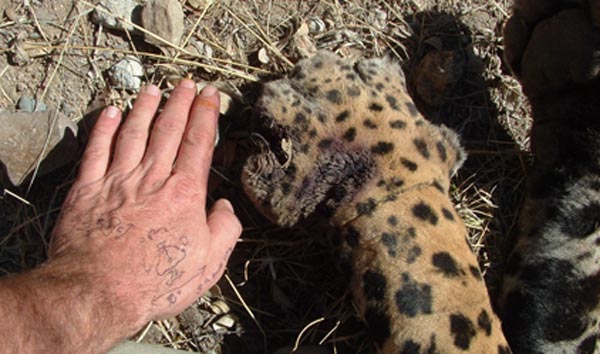
Janay:
I don’t know why snare a jaguar. I don’t know enough about trapping techniques and such. What I’d been told, what McCain had told me, which I found out to be completely false, is that when a jaguar gets caught in a snare – they are strong animals, they are built like a tank! So when they get caught in a snare, one of their feet is going to be caught, and initially they’ll fight but they’ll calm down. He told me they calm down because they’re reserving their energy for whoever comes back.
When you try to jab them with a tranquilizer dart, they just freak out and they will come at you with everything they have. Well, Macho B fought, and I don’t know how long he fought, but he was climbing this tree, clawing the tree, biting the tree, banging himself against – he just fought, and used probably every last ounce of strength he had to get the fuck out of that snare. He’d never been trapped before in his life, you know? It was probably just like any animal who’s never been trapped, used to going wherever they want to go, like “what the hell is happening to me?” And he fought, and it killed him. It just absolutely killed him.

There was one show I saw recently on National Geographic, and they’re snaring jaguars down in Belize, or Brazil, or somewhere, and the guy who does it, he’s been snaring cats for a long time now and has never lost one. They use that audio transmitter, so they know as soon as an animal is snared. They get to that snare quickly. So, it’s more controlled, it’s safer for that animal, they’re not fighting for so long, they can get them drugged – I don’t know what drugs they use, I don’t think it’s Telazol. So they can get that animal drugged, collared and on it’s way within a matter of an hour. With Macho B, it was probably more than a 24 hour ordeal, from the time he was snared until he came out of that drug and stumbled off with a collar wrapped around his neck and a yellow ear tag in one of his ears.
Jessica: So, next he’s running free, and he’s got this collar on…
Janay: Not even running, he’s stumbling away, and he walks a couple miles, beds down, and then the next day he walks to a pretty remote canyon. It’s rough country, but he didn’t walk that far, and he stayed there, barely moving, for twelve days until they came in to recapture him. He barely moved for twelve days. The emails back and forth between McCain and Game and Fish, he’s getting excited that “Macho B’s moved a hundred yards today”. Well, Macho B can move twelve miles in a day! A hundred yards is nothing! So I don’t know what was going on with McCain, why he didn’t want to give out where Macho B was located so that someone, anyone, a vet, could go in and see what was going on with this animal, because obviously something was wrong. It was clear something was wrong within days, but they waited weeks.
Nobody that was involved in this should have ever been involved with it, because they did not have the experience, they did not have the respect, the compassion, the professionalism – they had nothing that is required for the protection and the conservation of the jaguar. These people were in it for something else, I don’t know what it was. It was really tragic, he died a very slow and painful death for twelve days. His stomach was empty, he was dehydrated… I can’t imagine what he went through…
So, bottom line, snares should have never been put in his territory to begin with. Then, when pictures – and his tracks were even found in the area. When it was evident that he was in the area, snares should have been closed immediately. No questions asked.

Jessica: Do you want to talk about the aftermath of that, people trying to assess why this happened, how he died?
Janay: For the twelve days after he was snared, “it was an accident, it was an accident”. Then they killed him and they had a big press conference saying it was the humane thing to do. Renal failure. There was some people talking about maybe it was “capture myopathy”, not renal failure. I don’t know enough to talk about this intelligently, but it has something to do with when an animal is captured, it’s such a stressful experience on the body that their organs start shutting down. One of the symptoms that presents itself is muscle atrophy, and Macho B had that in both of his back legs.
So, Phoenix Zoo says it’s renal failure, then tissue gets sent to the University of Arizona lab, and they say it wasn’t renal failure. They can’t find evidence that his kidneys were failing, that it was more likely dehydration. And that’s kind of when things explode. I contact Tony Davis of the Arizona Daily Star (this is at the end of March) because it’s still the company line – for the past month it’s still “it’s an accident”, they don’t talk about anything they knew, like Macho B was in the area, nothing. Now someone else is saying maybe it’s really dehydration, so I go to Tony Davis because who else am I going to go to? I can’t go to one of the agencies, because they’re involved, I can’t go to any of the people I work for, because they’re involved. I go to Tony Davis, he writes an article and that’s when the federal criminal investigation was initiated – my coming forward.
But unfortunately his article just focuses on scat – that’s the main thing. The bigger picture is being lost this whole time, it’s just about scat. And what makes it worse is that McCain and Thorry Smith both say “there was no scat anywhere, I didn’t tell her to put scat out”. So, all the sudden its a he-said, she-said, and it’s about scat, and that’s the focus of the investigation. The agencies are breathing a big sigh of relief because nobody is questioning them about “why were snares there? did you know about Macho B’s presence? what were you thinking hiring the jaguar biologist to be the one setting snares in jaguar habitat? how can you say it was just for lions and bears?” You know, no one’s questioning them. So, that was the focus for a long time.
McCain was charged with an endangered species violation, the “take”. He pled guilty, and he was actually given immunity by the US Attorney’s Office. He refused to talk to the feds. US Fish and Wildlife Service were the ones investigating Macho B’s snaring and death, so he lied to them initially and then he cut off all contact, then he got himself a lawyer and sat down with the US Attorney’s Office and the US Fish and Wildlife Service. There were three or four interviews, he keeps on lying on the first couple interviews, by the third he’s sort of telling the truth, and this is all under immunity.
Jessica: How does he have immunity?
Janay: I don’t know. They gave him immunity. He pleads guilty. He gets five years’ probation and can’t work with big cats in the United States during that time period.
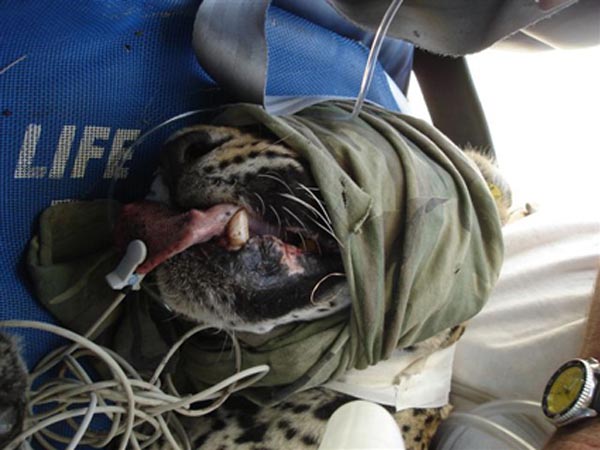
Then they charge me with the same crime. I pled not guilty, and then they offer me a plea deal, three years’ probation and I can’t work with big cats in the U.S. I said “no”, and then they charged me with conspiracy. That went on, I prepared for trial for almost a year. During this time I got to act as a legal assistant, so I got to read everything as we were preparing. With the trial, I was kind of hoping it would be exposing all of this stuff, but it wasn’t going to be. It was basically going to be scat, was there a permit, and did McCain tell me to do what I say he told me to do. By last March, a year ago, the US Attorney’s Office offered me “diversion” which is that they would drop the charges against me and I would just have to do a year light probation: I can’t work with big cats during that time in the United States, and they insisted I read this statement of fact in court for the record. Basically, it says what I’d already said, that I’d been directed to place scat at this snare, on and on. When you read it – Game and Fish, after I did this diversion, they kind of twisted everything so all the sudden it’s like “she finally admits that she was trying to capture the jaguar!” and all this crap.
But basically, yes, I was directed to place scat, McCain was trying to catch the jaguar, I was told there were permits, now I don’t believe there are permits, and that was the end. Now I’m on diversion.
The whole story has still not been told. The agencies have gotten away with everything, a lot of people involved with the agencies have gotten away with everything, and nothing has changed for the benefit of the jaguar at all. Nothing in conservation, I mean, these fools can do this all over again. They got away with it once, why not try it again if the opportunity presents itself?
Shaun: And there’s a new jaguar in this area?
Janay: There was a jaguar that was documented again by a lion hunter. He was out with his hound dogs, and his hounds treed this jaguar. He took pictures, getting within 30 feet of the tree the animal was in, which is defined as harassment under the Endangered Species law – what I was charged with. He gets pictures of it, publicizes it, so now there’s this new jaguar research project occurring. They’re going to do what we did, put cameras everywhere. My former boss, Jack Childs, who started the Borderland Jaguar Detection Project, is involved with this study. Ron Thompson, former Arizona Game and Fish, who hooked McCain up with the snaring job, who told McCain if you catch the jaguar, there are permits, everything is in place – I believe he’s also involved in this new jaguar project. I just feel it’s a matter of time, all these players who were there for Macho B are now there again, and here’s another jaguar.
So, this new jaguar project, they have to get an endangered species permit from the US Fish and Wildlife Service. That means whenever they get a jaguar detection, they have to give the coordinates to them. They’re probably going to have to do that with Arizona Game and Fish, because Game and Fish says they’re going to resume that lion and bear snaring project along the border. There’s going to be some coordination there, so hopefully they don’t catch the jaguar, and I just think it’ll happen again.
Jessica: Zooming out, why did this happen? What are the larger forces at play that let this happen?
Janay: Larger forces at play? Where was US Fish and Wildlife Service? This is what they are tasked to do. The Fish and Wildlife person, her title is Jaguar Lead – she was aware of the snaring project, aware that Macho B was in the area of the snares, was aware that Smith and McCain were seeking drug advice and dosage for a jaguar capture, she was aware of all of it and did nothing. Why, I have no idea. I have absolutely no idea.
Arizona Game and Fish was aware of all of the above, and they did nothing. I think they just saw it as, “here’s our chance, the only jaguar in the United States, we’re gonna get a collar on that guy, and we’re all gonna be famous. We’re all gonna be writing papers and we’re going to be able to say how we successfully captured this jaguar.” Whatever, maybe that’s what it was. Maybe it was all glory, I don’t know, but no one knew who was on first. That’s what they say, “we didn’t know this, we didn’t know that”, everyone’s got an excuse as to why it happened. But, they all knew what was going on and no one stopped it and I don’t know why.
Jessica: What was the public reaction? How do people think about jaguars and how did they react to this jaguar’s death?
Janay: A lot of people were incredibly upset. Even before I came forward, a lot of people were very suspicious of the agencies, especially Game and Fish. There’s a nickname for them: Arizona Maim and Squish. They’re just not very well respected, they had a huge involvement with the Mexican Grey Wolf that was reintroduced. Anyhow, the public was pretty much outraged when things started coming out about how Macho B died. They wanted accountability.
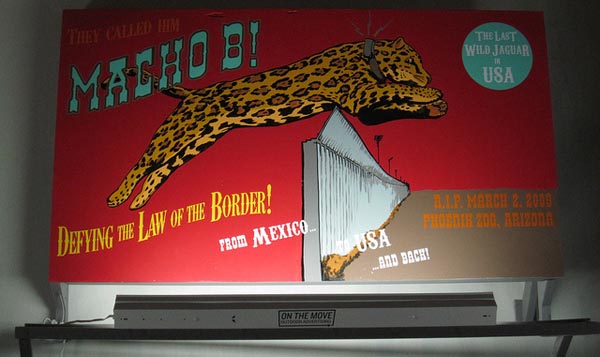
Shaun: What are the people who were involved doing now?
Janay: The guy who worked for Game and Fish, Ron Thompson, who’s now working on this new jaguar project that’s being run out of the University of Arizona – he had hooked McCain up with jobs down in Mexico. He has a guide business, where he takes hunters down there on ranches, and the ranchers kind of promise not to kill predators in exchange for these hunters coming down and paying however much money to kill a trophy buck or something like that. And then, those two, Thompson and McCain, two months after Macho B died, they went down to the Yucatan. They were involved in a project where two jaguars both got dental surgery and then were hard-released. Both of those animals died. The first one that died was wearing Macho B’s collar.
Shaun: I want to hear a bit about what you see as the future of this other jaguar, or the future of jaguars in general? When I first learned about Macho B, it was after he died, and it was “this was the last jaguar in the United States”.
Janay: Nobody knows, I think when you hear terms like “the last jaguar”, it’s usually a group using that to raise money for themselves. There were other jaguars, we documented other jaguar tracks when Macho B was around, we just never got their pictures. Jaguars are notorious for it taking awhile to get their picture, they can be camera shy, but there are other jaguars around. I don’t know what’s going to happen to them, it seems like the public is supportive of these animals being out there, but it seems like the agencies are just fricking clueless, and I don’t know what their intention is with these animals. They just seem to mess it up every which way they can, with and without trying.
After Macho B was killed, a group had sued the US Fish and Wildlife Service for critical habitat for jaguars. It had already been turned down, but now it was before a judge again. Ironically, the “last jaguar” is killed and now a judge is hearing this argument for critical habitat, which is something that, when an animal is listed as an endangered species there’s supposed to be a recovery plan and critical habitat that goes along pretty soon after that designation. That had never happened with jaguars. The judge granted it, but it made no sense that they’re doing this recovery project and critical habitat designation – so they’re going through now and saying “what would we call jaguar habitat, and how would we protect it?”
They’re wasting all this money and resources, but it’s really damned easy: you just get a map of where Department of Homeland Security has put a fence, see where there’s an opening, and that’s where every animal is going to go through. Human, jaguar, deer, toads, snake, it doesn’t matter. That’s all you need to know, and in Arizona, most of that land on the North side of that border is protected in some way – it’s either National Forest, Wildlife Refuge, it’s already protected in some manner, or maybe it’s a huge amount of private land. So, it’s not like there’s a subdivision on the other side of that fence in most cases.
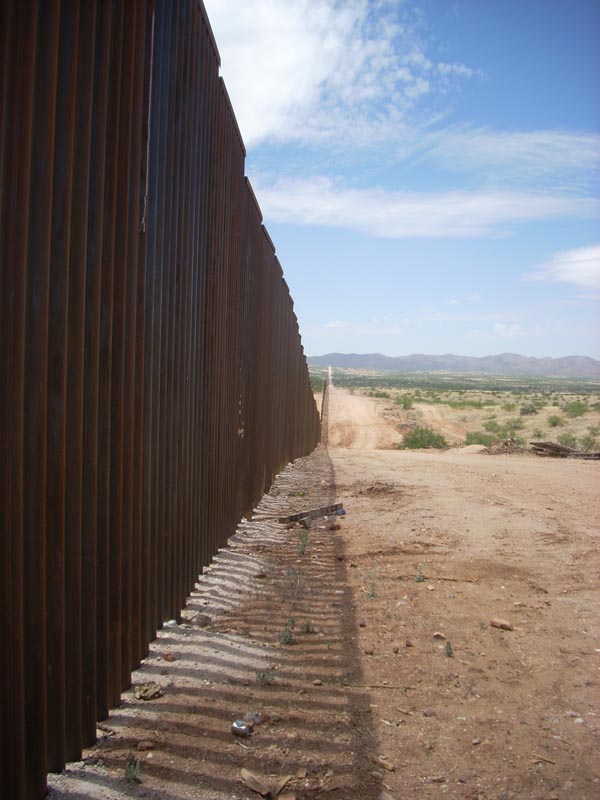
Jessica: Can you talk about the border fence? How much land is being cut off – how is this effecting jaguars and other wildlife?
Janay: You can apply the logic that there’s a fence, a barrier, people can dig a tunnel under it, climb over it, walk around it, but animals can’t – I mean, we don’t have monkeys around here, as far as I know – but they can’t get over it. I mean, it’s high, it’s like sixteen feet. I just wrote an article: there was a lion on a wildlife refuge down by the border. A border patrol agent was on patrol and just came across this lion running in front of this fence because he can’t get across. And, it’s a wall – it’s not even a fence, it’s a border wall. It looks like a jail cell. It’s metal, and it goes up like sixteen feet, there’s four inch space between these steel bars.
This lion was going back and forth, trying to find a way, sticking it’s head through the bars. So, this border patrol agent takes pictures, takes video I think with his phone. He has no idea where he is, has no idea he’s on a wildlife refuge, first of all. So, he calls everyone, he shares the pictures with the agents and promises to share the video. Well, Department of Homeland Security finds out that this guy’s got pictures and they confiscate them all. The pictures get out but the video never gets out, and the video is of the lion trying to get through the wall. Apparently they seized it because it was bad press, community relations – environmental groups would go nuts if they saw this lion trying to jab his head through this four inch space to try to get to the other side.
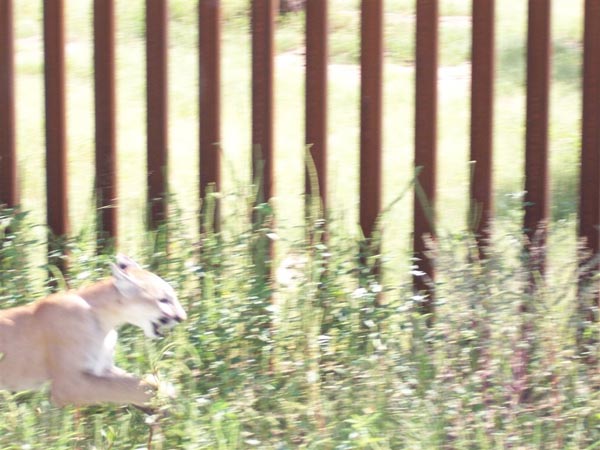
So, logically animals can’t get around this wall. In some areas along the border they’ve got these huge lights, they draw in moths and bats, so you’re dealing with that whole thing and there are a lot of plants that are only pollinated by certain bats or moths. Then you’ve got all the patrols, you’ve got where there isn’t a fence and all the people are being funneled through so you’ve got that destruction. The pollution that comes with human migration is just overwhelming.
Jessica: Really? Describe this.
Janay: It is so disgusting. When people come across the border, they’re usually going to some place where they’re going to get picked up. No one can cross the border anymore without hiring a “coyote”, a human guide. That’s a couple thousand bucks. If the guide’s going to get them across – usually there’s what they call “layups”, and it’s where they’re going to wait for their ride, or maybe where they’re resting, like a halfway point. Some of these are huge, and inches deep with trash. They come across, and the coyote will tell them “only take X, Y, and Z”, so maybe they’ve brought water, you change into fresh clothes, everything else is discarded. You’ve got backpacks, pictures, deodorant… a lot of people coming over have been given pills that have caffeine or sugar or something to keep them up, because they’re always supposed to be moving. There’s meth, cocaine in tequila that they’re drinking, you’ve got these speed pills, you’ve got human feces, toilet paper stained with human feces – it’s disgusting. Medications… it goes on and on and on. It’s a health hazard for everything.
In some places where people are being funneled, there’s sources of water, and you know in the desert water is like gold. This waters being polluted, what’s that effecting? No one knows the bigger scope of what is going on.

There’s so many implications for this. For the wildlife, they’re fucked. Here they are, walled off here, so maybe they can adapt and then they go over there, but that happens to be a funneling point for a bunch of people so now they’re being pushed in another direction, maybe where they get their water is polluted. How does that effect them? I’ve seen javelina and coati digging under trash, maybe they’re eating those speed pills? What does that do to them? There’s plastic bags everywhere – the ranchers have a huge problem with this, with cows eating the plastic bags, and they end up dying a horrible death because of it. What else is eating those plastic bags? It just goes on and on.
Shaun: What happens next for you after all this?
Janay: After all this, I have no idea. I am working on a book about the bigger picture of what happened to Macho B, talking about the agencies, conservation, everything like that, hoping to get this story out there more. I’ve started a blog as well. I just want to advocate for the respect and compassion for not only the jaguar, but for all wildlife, and make sure that they really are being protected by the people that are being tasked with protecting them. To prevent something like this from happening again. I would love to find a way of preventing biologists from going from project to project if they have a history of breaking laws or killing “x” many animals – you know, why is that? What’s going on there? I’d like to probe that more. It’s my guess that this is a big problem, and maybe part of why there are still threatened species – it’s part of that equation anyway, I’d like to find a way to work on that.
I hope to go back to Arizona soon – I need sunshine!
Janay’s blog, “Whistling for the Jaguar: the un-redacted story of Macho B”, can be read here. Her book, Cloak and Jaguar: Following a Cat from Desert to Courtroom, is due out in fall of 2015.
(trail camera and border wall pictures courtesy of Janay Brun)
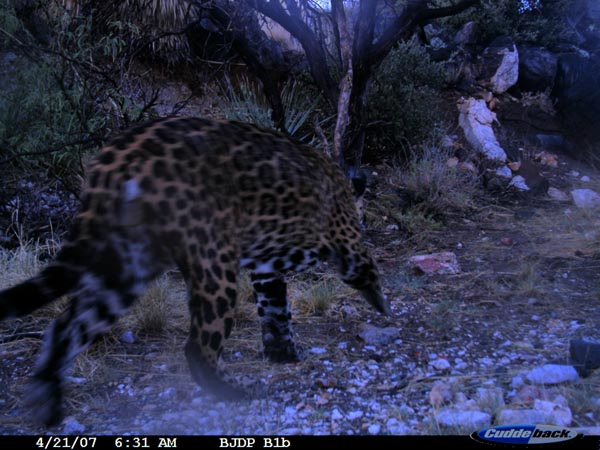
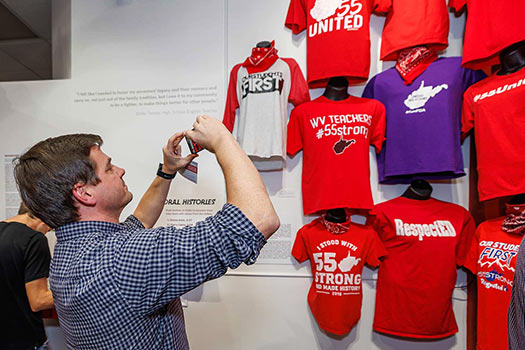
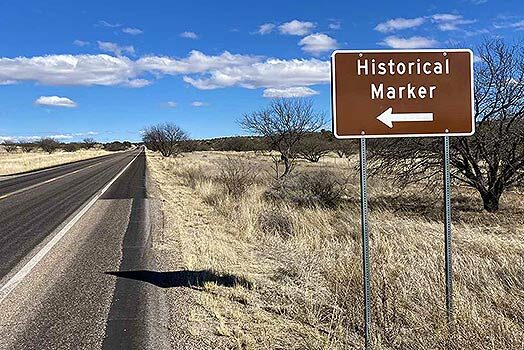


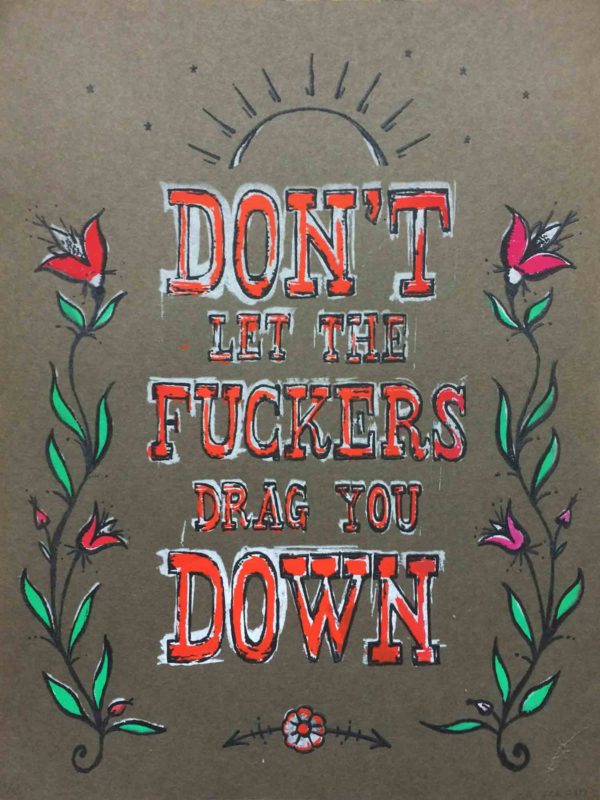


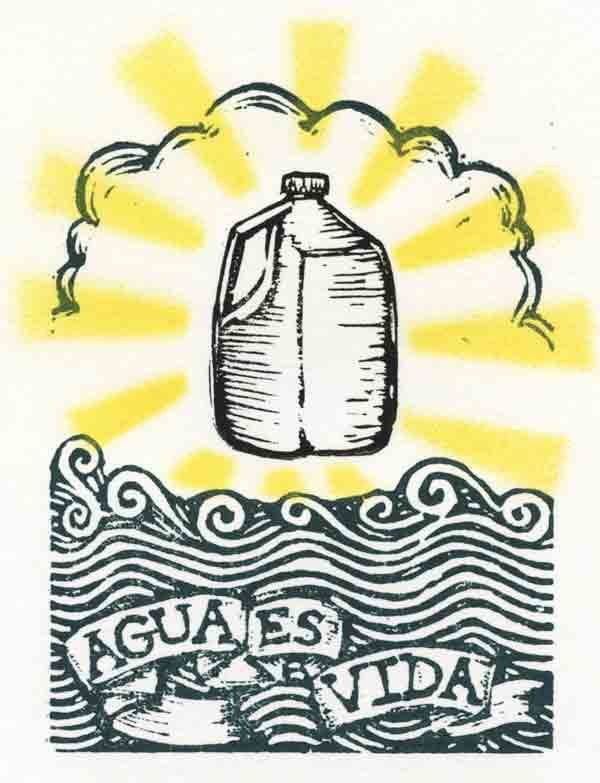
Infuriates me to hear wildlife, especially exotics ths we should be protecting are maimed or killed by stupidity of mankind. Who are we to have that kind of haphazard control of wildlife.
As for the waste that is contaminating & killing wildlife by illegal immigrants, that is horrendous . I had no idea of the significance & enormity of the problem. What can gvmt do to lessen the impact of that? Are they even concerned?
Thank u for the article. I’m so sad for Macho B & the terrible death he suffered. Should never have happened & should not happen ever again.